I’m working in districts where we have been in school for 5-8 weeks.  This show is in response to some challenges and reflections on what I want to emphasize more. You can listen to this show right here or on your favorite podcast app.
This show is in response to some challenges and reflections on what I want to emphasize more. You can listen to this show right here or on your favorite podcast app.
Listen to “BAP111 Instead of IDK for SLIFE and Newcomers” on Spreaker.
An edited transcript follows with links to what I talked about:
This episode is going to be about lessons learned. I think there’s value no matter what you do if you’re a teacher, instructional coach, or administrator.
This is that time of the year when the honeymoon is over! LOL. Things are playing out in a certain way depending on what routines you put in place or did not put in place. What I’ve learned is that in many places where we’re not getting things off the ground with students, it’s because this strategy is not in place. We are realizing that we did not emphasize the teaching of this skill enough.
So let me offer you the strategy, and then I’m going to tell you why it’s so critical for new arrival students. And this one is important for even your highest flyer in your classroom no matter what you teach. And I’m also going to tell you about a fail, so look forward to that. People always say they love hearing about what didn’t go right or a non-example when I’m trying things.
So this fail is kind of funny too. All right, so here’s the strategy.
The sheltered strategy is to Teach Kids What to Say When They Don’t Know What to Say.
Let me say that again. We’re going to teach kids what to say when they don’t know what to say. Some teachers know this as an “Instead of ‘I don’t know’ poster.” We are working to remove “IDK” from our classrooms.
So let’s think about it a little bit differently. We’re not talking about a poster. Idk is what the students use. Many students text, I don’t know Idk. All right?
Teach Ss Day 1 what to say instead of IDK. Opting out is not an option for Learners. @MsSalvac #supportingSIFE #BoostingAchievement @LearnTexas pic.twitter.com/djeBCMzs6p
— Trish Hinze (@TrishHinze) July 17, 2019
Often you will see a poster that says IDK, and it has an X through it in a classroom. The idea is that we are not going to say, ‘I don’t know’ anymore. Instead, we want to encourage other things such as: May I ask a friend for help? Would you please repeat the question? Where can I find more information? May I have some time to think? etc. That’s a fantastic poster to have. T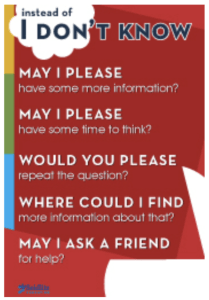 he company I work for, Seidlitz Education, sells these great posters of things that say, they’re beautiful.
he company I work for, Seidlitz Education, sells these great posters of things that say, they’re beautiful.
WHY is this Important? Can the Students Tell Us?
If you ask the kids, why is it important to say other things instead of I Don’t Know, could they tell us? Have we talked with them about this and let them come up with answers. This offers relevancy.
If I asked you to come up with three reasons why it is important for young people to say something instead of I don’t know, I bet you could. As adults, we have built a skill where we might pause and say something like “Could you give me a minute?” Or “Can I ask someone to help me with this?”
Just Google It!
You know, the reality is that we don’t use the skill so much anymore. Now we just ask Alexa. Or we ask Google. We google it. That’s kind of dangerous for the world, don’t you think? In the Boosting Achievement book that I wrote with Anna Mattis, we cite researchers that talk about how a part of our brain is starting to atrophy because of technology. We don’t have to think deeply anymore. So then it is more important than ever that our classrooms are places where we can practice thinking, be more curious. Be more curious. Don’t just default to I don’t know.
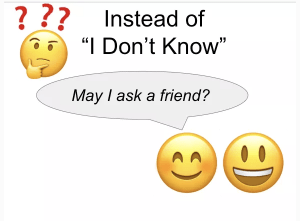 It’s a teenage culture kind of thing, right? I’m sure you can appreciate, even for your own child, do you want them to be okay with not knowing? So the first one that I always teach is, May I ask a friend for help? Because I’m trying to create a culture of conversation. And as soon as the student says that, we say, yes. And I’m going to hover around that student, and I’m going to make eye contact, and I’m going to ask them, Are you ok to answer before we come back. I might have to give them the answer. We need them to have a win in that moment in front of everybody. And if they didn’t know the answer, they may not be the only one. They’re likely not the only one that doesn’t know.
It’s a teenage culture kind of thing, right? I’m sure you can appreciate, even for your own child, do you want them to be okay with not knowing? So the first one that I always teach is, May I ask a friend for help? Because I’m trying to create a culture of conversation. And as soon as the student says that, we say, yes. And I’m going to hover around that student, and I’m going to make eye contact, and I’m going to ask them, Are you ok to answer before we come back. I might have to give them the answer. We need them to have a win in that moment in front of everybody. And if they didn’t know the answer, they may not be the only one. They’re likely not the only one that doesn’t know.
Why is QSSSA not Working?
I’m going to talk about the Newcomer classroom. I am always talking about the newcomer student. This week, I was in a newcomer classroom where the majority of the students have missed large amounts of formal education, and we are at high school. The issue is that the students are not turning and talking when we want them to. And we have a really good structure, QSSSA, for students to turn and talk. But they’re still not talking to each other as much as we would like for them to, even when we encourage the use of native language. We just don’t have it off the ground.
Modeling for Teachers
A part of my job is modeling for teachers. So I decided I would model how to get this strategy off the ground with a class where most of the students are new to the target language of English. I never promise that I can pull off a spur of the moment lesson well. It is a challenge to model because I don’t know the kids and I don’t know the content. But I’m willing. I feel that it is important to be vulnerable enough to do these things to support the teachers. Even if the lesson doesn’t go as planned, we get a chance to debrief and so we are both going to come out better.
Using Native Language
So remember that most of the kids in the classroom don’t understand what I’m saying. Now, a lot of these kids speak Spanish, so I’m going to just be honest, my first instinct would be to just say it in Spanish. I speak Spanish. And this is not the moment to worry about language acquisition. This is the moment to worry about teaching a skill so that we can acquire more English! Routines, directions, telling a student how amazing they are…Those kinds of messages we need to get across, however we can get them across. Use your entire language repertoire to communicate these things. We have Google Translate and I will use it or whatever I need to use to help me , might use whatever I need to make sure they understand.
#SeidlitzEdChat
If anyone needs an "Instead of IDK" poster for thier #virtualclassroom here you go! #KeepItSimple #ells pic.twitter.com/BoEbq8SaQY— Dr. Carol Salva (@DrCarolSalva) May 20, 2020
A key word or phrase is always okay. – Said by Nancy Motley in one of my first ESL trainings.)
But as the instructor, I want to stay in English as much as possible. I’m the model. I would only just pop out of English for a moment and come right back in. I don’t want them to think that I will be translating everything. I want them to get comprehensible input (understandable messages) with me staying in English as much as possible. But again, this is so important that I would use my Spanish. Absolutely. Not a problem for me. It always has worked out just fine.
Translation Can’t be our Go-To Strategy for Comprehensible Input
I have no problem using Spanish from time to time but the teacher I was working with does not speak Spanish! And another thing is that several kids in there don’t speak Spanish! I could use Google Translate and I would still use some Spanish translation, though. I would still do it because the majority were Spanish speaking kids and they just communicate kid-to-kid better than they can with me often. They’re friends. So I would do it, but I would be thinking “What about my student that speaks Farsi? What about the child that speaks Arabic? Are they getting it?” And so translation cannot be our comprehensible input default. And as the year goes on, I want to make sure it’s not because more kids have more comprehension and I should not need to translate at all anything pretty soon. So anyway, the teacher I was working with didn’t speak Spanish, and I want to make sure that I’m trying to model something that they can do easily.
How do I Get Buy-In for This Norm?
Okay, so here’s how it looks if everybody speaks English in my classroom. I would write “I Don’t Know.” on the board and talk about how it is OK not to know answers. I’d give them a scenario in life like if I’m at the bank and they ask me, “What is your husband’s mother’s maiden name?” I might just need a minute. I might know it, but I might just say, “Can you hang on just a moment? Can you give me a minute to think?” My husband might be in the car, and so I might instead ask them if I could go ask him for help.
Most importantly, I want them to talk to each other. I’d like the students to talk and to tell me why is this important. I want their buy-in. This is a lesson. It is not just, ‘Hey, we’re going to start doing this today.’
We can just write one thing on the anchor chart and add to it throughout the year. But they need to buy-in. They need to understand why it’s important. So I would have that “I Don’t Know” written on the anchor chart and at that point, I would cross it out. Then I would add “Instead of…” and we can start writing other things we could say onto that poster.
Poster vs. Anchor Chart
Instead of ‘poster,’ let’s call it an anchor chart. It needs to be big enough for the kids on the other side of the room to be able to read it. Any environmental print needs to be big enough, written in big enough print, that it’s usable no matter where you’re sitting in the class. And it needs to be referenced. Otherwise, it is just decoration.
On a mission to increase engagement for early ELs, @PantherNation_1 Ms. Carter begins virtual classes with a purpose statement (doubles as fluency practice), images to support growth mindset and @MsSalvac IDK chart 🙌🙌. @MNPS_EL pic.twitter.com/BfUzlt7lb3
— Heather W. Goodridge (@h_woodroof) September 3, 2020
NO FORCED OUTPUT
That’s how it goes when everybody speaks English. So now I will explain what I do when they don’t comprehend much English.
I want to say, before I start to tell you about the simulation, No Forced Output. That’s a mantra in my mind that I’m saying to myself as I walk in front of a class of new arrival students or any students, no forced output. I am not going to force anyone. I’m never going to force a kid to speak in English. When they’re acquiring English, it’s just so cringy. And it is doing the opposite, the exact opposite of what I want, which is a low-stress environment where they can acquire, consume, and comprehend as much English as possible.
I want that to go as fast as possible. And there’s a researcher named Steven Krashen who will tell you it’s really all about reading. And he’s right, in my experience. I want to get them reading with support, high interest, compelling things, acquiring and understanding these words as they start to understand how they sound and as they start to use them, we get it off the ground, and it starts going so fast.
They have to be comfortable for that. They have to be really comfortable. Not freaked out. So whatever I’m doing in front of the class, they can attend to it, they can see it, they can get it. They can start getting little things. They can be comfortable enough to talk to their partner in a low-stress way.
QSSSA
One-to-one is low stress, so use whatever language, but I want them to talk to each other. Some of them won’t even talk to each other in their native language.
Think about that. A turn-and-talk. What could go wrong with a turn and talk in a regular math class? I’m sure you’re thinking a lot of things.
They’re not talking about what I want them to talk about….
One of them is doing all the talking…
They weren’t paying attention, so they don’t know.
And on and on…
QSSSA is a routine that helps solve for so many of the challenges we face when we want students to Turn and Talk. It’s a top tip. It is our top tip. I work for a company called Sidelitz Education, and QSSSA is always a Top Tip! Chris Hagy of Charleston, SC has a padlet on the technique here. And this script by Michelle Gill is popular:
 Loading...
Loading...
That routine is one of John Seidlitz’ Seven Steps to a Language-rich, Interactive Classroom. It is a fantastic routine. But guess what step one is? Step one is teach kids what to say when they don’t know what to say.
Teaching Students what to Say instead of IDK is STEP ONE.
That is step one for a reason. We need low-stress environments where everybody is willing to take risks. See, I don’t want to force them to speak in English, but I do want to arm them with something they can take anywhere they go in the building and also not be so worried that they’re going to be called on. So this “Instead of “I don’t know” poster that we’re creating, I have a little one for you.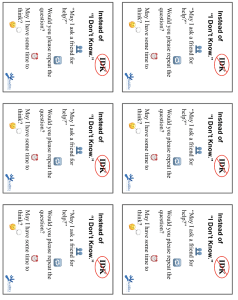
They’re about six to a page and you can just print them out and cut them up and tape them to the desk. Tape them to their agenda. Have a big one on the wall and also tape these on their Chromebook and everywhere so they can take it with them because it’s a skill. It is what they might need at the doctor’s office. To use in math class. To use everywhere.
The Fail
Okay, so I’m walking to the front of a classroom where kids do not speak English. The class is for that. And these are new arrival students. And it’s at the beginning of the school year and it’s specifically for students who have missed education. So imagine there’s not much comprehension across the board. So I went up there and I wrote, I don’t know on the board. And you see kids, they’re looking at it quizzically. So I think, “I’m going to explain this like I always do, but I’ll just use gestures.”
So for whatever reason, I pointed to my eye in my face. Ha! I’m going to try not to laugh because it was so ridiculous. So I pointed to my eye, but then immediately I was like, no, not that kind of eye .. I. And I pointed to my chest and I saw a kid mouth “me” as soon as I pointed to my chest. He mouthed me and I was like, yes, like me… I. And another student pointed at me, like at the teacher, and said, I? No, no, no… now my mind is racing. I’m thinking, God! Because you know what? I did this for a living, for years. But every time I go in front of a class, I get slapped back into reality of how hard it really is. It is not easy to teach, period. But you forget how intentional you need to be to teach newcomers effectively. But I need this vulnerability. I need to be up there so that I can help. I don’t have to have a magic wand and do anything perfectly. Or say “just do this!” I was up there so we can figure out things together. And I know there’s a way to do this with newcomers. I’m just thinking, “Why didn’t I think about this before I walked up here??”
I was like, no, I (pointing at my chest). Of course some kids got it. “I” is a very common high-frequency word. I like, I am here. Okay, let me just go on to “Don’t”… the word “Don’t.” So I pointed to the word don’t, and I said, Say “don’t”, and everybody repeated it.
I wagged my finger like, no… like you’re shaming somebody.
Don’t… don’t… Don’t
And one of them said, “no.” And I said, yeah like “no.” But he was saying, “I no?”
No. So when I was shaking my finger back and forth, they were getting “no” like yes or no. So I was like yeah, it’s no…but it’s don’t. And I’m trying to think, how do you say don’t? How do you convey don’t without saying no? Because the next word is know!
I don’t know.
So then I was like, okay, don’t. Just say don’t, and then no. And then point into my temple….know.
I know they’re thinking, “I no no? And that no is with a K??”
Okay, right there. Let’s just stop. This all happened in just a few seconds, right? To me, it is so funny.
Making Things Harder Than They Need to Be
It is so funny because I’m just making it so much harder than it needs to be. As always. As always, I’m making it way harder than it needs to be. Let’s back up. I could have said it in Spanish because one kid finally did say “No Se?” That’s beautiful. Yes! Throughout the school year, if they say it in Spanish, I’m going to say, yeah, exactly. Or if they get it, yeah. I don’t care if they translate to each other all year long. I just don’t want that to be their go-to either. But anyway, as soon as he said No Sé, I wrote No Sé. And they’re like, yeah, okay. But there were still kids in the class that don’t speak Spanish. But I did see that they can help each other understand this. I saw a kid turn to another kid and make the gesture like shoulders up, palms up. 🤷🏻♀️ Yes. That kids should be teaching. LOL!
That kid should be teaching. Because here’s how I’m going to always do it from this point forward. They all got it when I made this noise, when I shrugged my shoulders, when I put my palms up, and when I made the “I Don’t Know” sound… it isn’t even a word. It is a sound. So that gesture with your shoulders up and your palms up, that resulted in 100% of them getting it. And they started laughing, and they’re like, okay, we get it.
I can also invite our kids who do have literacy in Arabic or something else to come and write that over here on this anchor chart. There’s nothing wrong with the native language. In fact, it’s powerful. But I want the English words big as that is our target language in this class.
So they understand this is what we’re talking about. But they needed to understand, just like any class, what does it look like in a class? So let me circle back that little moment that I had in front of that class. That little fail, I call it, was such a fantastic learning opportunity for me and for the teacher. At least I know it was for me and I hope for him because we debriefed afterward that we’re just making it harder than it needs to be.
Collaborate with Like Minded Educators
This is the kind of thing I get better at because I reflect on it. I am reflecting on it right now in this podcast. But I want to talk with or communicate with other educators to remind me of the basic things that are most powerful. And things like ‘When is native language okay?’ Again, A keyword or phrase is always okay for the teacher. I mean, when is native language okay for the students in an ESL classroom?
Always, always allow and honor their native language.
Students can use your entire language repertoire in this class because I have a language target. I have a language objective today. Our language objective is “We will use language such as “May I ask a friend for help?” and “Would you please repeat the question?”
That’s our language target today. And we all repeated it at the beginning of class in unison because that is low-stress. I’m not forcing anybody, but if we say it all together, you know, and we used it several times in the class, and I’m constantly bringing them back into English. The ones who can speak English, the ones who are able to repeat, the ones who are we’re constantly coaching for that through the entire 39 minutes. But you have to use your native language.
It’s a source of comfort. Your funds of knowledge live there… everything that you’re able to express.
I have a kid who speaks Spanish and a kid who speaks Arabic sitting together. And they do great, but they do use some of their native language. Their common language is English, but they can communicate with each other using everything they have.

We want to create a culture of conversation. And that conversation, we cannot force it all to be in English. But there’s more and more English as we are going through the year. I promise this is the answer. Low-stress environments, low-stress opportunities for output.
Opportunities for output. No forced output. And tons of comprehensible input. Tons of messages that you start to understand, what does that person mean? What are they trying to get across to me in this language? 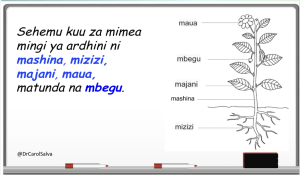
Comprehensible input would be in the target language of English in that classroom. But comprehensible. So me making that gesture really exaggerated…it’s comprehensible. It was more comprehensible than anything else I was doing up there. So we just played around with it. We’re just playing around with it.
Partner with Students. Be Transparent
And you know, what is great about what happened is the kids don’t forget it. The kids won’t forget it if it’s a fail like that. I’m just transparent with them. I was always telling my students that I’m learning how to be a better teacher every day. That’s what other people say, too.
I have heard Instructional Coaches say they don’t model because they don’t want to take the power away from the teacher. NO. You won’t take the power away from that teacher. I don’t believe that for a minute. Let’s hold students to a higher regard. Partner with the students. I’m trying to get better about that. Right when I walk in, if they let me introduce myself, I want to say “Hi, I’m Dr. Salva. Your teacher and I are both learning. We’re always learning. I hope for you that your whole life you will be learning. So today we’re going to try some things together because I want to learn, and he wants to learn. And we’re always working together to get better at things, to get better at teaching you. And so what I learned from you, too. And you guys learn from us. So we’re going to try some things in here and see how they go.”
I mean, that’s just transparent because we’re all still just on this journey, all of us, me, the teacher, the principal, the kids, all of us. Hold them in high regard. We are all learning together, okay?
So Instead of, ‘I Don’t Know.’
Here are some things for my journey of learning lately on supporting teachers:
It’s not a poster. The strategy is not a poster because a poster is just decoration. If the kids aren’t using it, if we haven’t implemented it. And so if you look around your room and it is a small thing where kids can’t access it, or if we only talked about it one time, that’s where we learned, okay? We haven’t emphasized it enough.
We haven’t made it a norm. We haven’t made it our default. We haven’t spent time making sure our highest kid in the class uses it, because we ask them questions that they would need to use it like, “Can you tell me more about that?” Or “Can you say it another way?” Or “Why? Why do you think that?”
Are we using this to help with rigor? Those kinds of higher-order questions would have your highest kids going, hhhmmmmmmm…. So you can offer them, “Okay, do you want a moment? Do you want to use something from the poster?” We want all the kids to see that it’s for all the kids. So your highest kids have to buy into it. And if we want our students to buy into this technique, we need to give them the relevancy. We need to explain all of this and make sure they all understand why it’s important.
Motivation – Helping Them Find It
We had kids speaking in their native language to each other and coming up with ideas of why it’s important because that was the thing. We need buy in from students. We need them to buy into this.
Larry Ferlazzo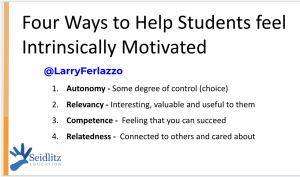 has written a lot on how to help kids be intrinsically motivated. I’ll link to one of his articles. Here are the four things.
has written a lot on how to help kids be intrinsically motivated. I’ll link to one of his articles. Here are the four things.
I say them all the time. (I’m a Larry Ferlazzo groupie.) The researchers agree. If you want kids to be motivated, if you want people to find their motivation, intrinsic motivation, put these four things in the environment.
- Relevancy like I just said, why is it relevant? How is it relevant? Why is it relevant to you? Why should you care.
- Relatedness that’s relationships. Teachers have relationships with students, and students have relationships with each other, and we want to work on those because it really helps motivation. So relevancy, relatedness another one is:
- Autonomy or choice. So I give them that anchor chart, and you can choose whatever one you want to say. But how much choice you have in anything helps you be more motivated about doing it. And then the fourth thing that Larry writes about is:
- Competence. A sense of competence. That doesn’t mean I’ve mastered it. It means I feel myself getting better at it. I’ve had a little win.
So that whole technique instead of I don’t know, it’s not a poster, it’s a skill. What do you do when you don’t know what to say? What can you say? So that’s what I was saying.
Recap on Some Things That Can Go Wrong
What can go wrong is that we can have it to where it’s just a poster. It may even be a poster that they can’t read. So to offset that, to mitigate those challenges, we would use it more often. Explain it. Explain the relevancy.
Have kids talking to each other, your relationship with them, hold them in high regard that you want their opinion about why it’s important and even using it, explain to them, we’re doing it in here, not because I’m the teacher and I want you to answer it’s because your voice is important. Your voice is important. And you may just need a moment. You may just need your friend to remind you of something. You may not know the answer, but that’s okay. You know a lot of other things, and together we know a lot.
Don’t Force Output but Expect Them to Use These Phrases?
So it may sound counterintuitive. Like what I’m saying is make sure they know what to say, but don’t force output. Okay…I don’t care if they say it in Spanish. I don’t care. I mean, once they’re comfortable. If I get a brand new student that come this week, I’m going back to relatedness. I’m going to have a conversation with them one on one, and I’m going to use Google Translate to make sure they know that they are in a safe place. That I’m not going to randomly call on them. They’re new. I’m going to respect their need for support, but I’m going to have a lot of conversations with them. They’re going to be pretty comfortable sooner versus later. They will be ready because they’re in a classroom where we do these things and they’re going to see this is how we roll in here. This is a very safe place. So when I do finally call on them, it’s okay for them to answer in whatever language. It’s okay for them to use their entire language repertoire to answer.
Or they can even give me a signal.! They can even point to it in the book when they are new or nervous. And I’ll say, “Yeah, right! The answer is landforms. You see this? Landforms. What he’s saying is ‘This week we are studying landforms’. That is the right answer! Let’s all say that…”
If I’m trying to get complete sentences out of everyone’s mouth, we can do them in unison. And I can honor this child, whatever their language.
So think about your language learners. If you’re teaching language learners, they have different proficiency levels, and so a brand new student is not the time to force output, but they can be included. Inclusion! They can understand way more than they can say usually. So let’s make them comfortable. They can attend, they can repeat, and in low-stress environments it all works better. Remember, low stress opportunities for output.
Low-stress output could be one-to-one. That would be a whisper read to my teacher. That would be with the students getting comfortable talking to the person next to them one-to-one.
A Culture of Conversation
And I can walk around and listen. I can get a formative assessment. That’s better than me calling on one student that doesn’t know the answer or only calling on the professional answer. Always, if I call on somebody and they don’t know the answer, they can ask me something from the poster, or they can even point to the one on the poster and I can say “Yeah, this one says, May I ask a friend? Let’s all say that. May I ask a friend? Yes. Okay… everybody. Ask your friend what do they think? And we’ll come right back to this person.”
But again, I’m going to make sure they have a WIN. See, with QSSSA, and Teaching kids what to say instead of IDK, you’re well on your way to a very language rich, interactive classroom. I’m just asking you to respect the need for support of a brand new student, but in a way that allows them to acquire the language as quickly as possible.
I’m going to wrap up the show now and thank you for helping me reflect that’s, what I just did. This is my journey of learning. And thank you to everybody that’s allowing me to work with them and support them in their classrooms, in their districts, with training, with modeling, with coaching. Reach out. If you have any questions about that, you can find me on Twitter. I’m @DrCarolSalva or Come over to Facebook with us. I’m also on Instagram but I don’t check that regularly. Sorry.
Last Thought
One more thing on “Instead of I don’t know.” Think about the cumulative effect of that over a person’s life. Think about a student, what effect you’re having if you help someone build that skill right now over the course of their lives. A person who doesn’t just go, “I don’t know,” especially in this age of technology. What does that do for them in their working groups, in their lives, as they walk through their day, as they get their first job, as they get their next job? Look at the long game, always. Let’s look at the long game and realize the effect. That’s what I’m asking you to do is realize YOUR effect. Little things add up and they have major effects over a person’s life. So that relatedness that relationship you’re building with that student, it makes a difference. Hold them in high regard. Hold every one of them in high esteem. Their voice is important, and you want them to have that skill so that as they go through life, they can show what they know and they can get the answers they don’t know, and they can add to their knowledge because the sky’s the limit.
Please stop and reflect on the huge impact you’re having on students. Thank you for everything you’re doing.
Bye.
PS: Check Out Upcoming Events! We have a lot of places we can meet IRL!!
